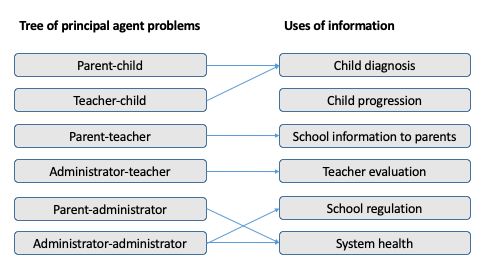There are inherent information asymmetry problems in education that are characterised using the lens of the principal-agent framework. Principal-agent problems exist when the principal hires an agent to act on her behalf but the interests of the principal and the agent are not perfectly aligned. This necessitates that the principal has information to monitor the agent’s effort. Typically, in education, there is information asymmetry between parent-child, teacher-child, parent-school/teacher, parent-administrator, administrator-administrator, and administrator-teacher. Administrator means administrator at different units—school, block, district, state and nation (Bergbauer, Hanushek, and Woessmann 2018). These principal-agent problems can be linked to different uses such as child diagnosis, child progression into university, school information to parents, school regulation, teacher evaluation and so on (Figure 1).

Enlarge this image
Figure 1: Tree of principal-agent problems and different information uses; Adapted from Bergbauer, Hanushek, and Woessmann 2018
A common solution to some of these information gaps is to use learning outcomes assessment. In the two decades preceding 2020, India has had some measures of learning outcomes. These include initiatives by the government institute, National Council of Educational Research and Training (NCERT); non-governmental organisation, Pratham; state governments; and private organisations such as Educational Initiative. In addition to national assessments, Tamil Nadu and Himachal Pradesh also participated in the OECD’s Programme for International Student Assessment (PISA) in 2009. Besides these, we also have in-class assessments.
Although the proliferation of multiple assessment organisations and tools is commendable, the assessments have had a limited impact on driving change in school or administrative practices. There is a lack of systematic thinking on the question of the right tool and the right use. This is evident by the low learning outcomes across the country, despite years of assessments pointing in the same direction. This requires a rethink of the assessment framework—what are the different tools and tests available currently, how may they be best used to fill the existing information gaps and what gaps remain to be filled with new tools.
Assessments that solve one kind of information problem may not be suitable for another. For example, tests that evaluate children for progression to university, such as board exams in India, are different from tests that evaluate schools or tests that evaluate teacher performance. The conflation of multiple uses in one is seen for assessments such as Board exams. Board exams are designed to assess child performance for progression but have been at times used as indicators of school performance. Unless we isolate the child effort and background from school effort, board exam results are not valid indicators of school effort.
The latest draft of the National Education Policy released in 2019, led by Dr Kasturirangan, proposes multiple ideas to reform existing assessment practices and also introduces new ways to employ assessments. The document lays out a number of new test uses—low stakes assessments to personalise teaching, national achievement survey for periodic health check-up, census assessment for disclosing school performance and board exam reforms for student progression. Yet, even as the draft policy lays out these different tests, it lacks lucidity on the problem each of these tests solves, the information gap it fills, and the use it will be put to. Critical terms such as ‘developmental purposes’ and ‘health check-up’ remain vague and open for interpretation. In light of these developments, it is critical to identify clear and plausible objectives of each test that we carry out currently. What are the principal-agent problems NAS can solve? What are the principal-agent problems board exams solve? What is the role of in-class tests? How can census assessments be used for school accountability? To answer these, we need to tackle each principle-agent problem systematically—parent-child, parent-teacher, teacher-child, parent-administrator, administrator-teacher.
This brief looks at three uses of information, i.e., school information to parents, school regulation, and system health, and explores the role of assessments in each.

